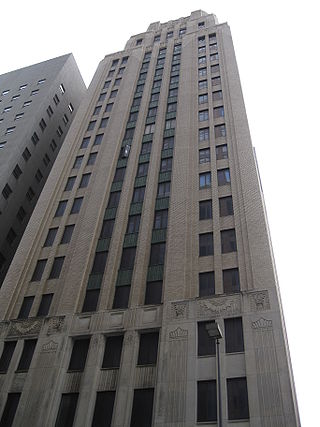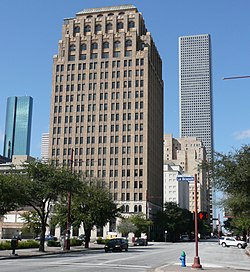Texaco, Inc. is an American oil brand owned and operated by Chevron Corporation. Its flagship product is its fuel "Texaco with Techron". It also owned the Havoline motor oil brand. Texaco was an independent company until its refining operations merged into Chevron, at which time most of its station franchises were divested to Shell plc through its American division.

Downtown is the largest central business district in the city of Houston and the largest in the state of Texas, located near the geographic center of the metropolitan area at the confluence of Interstate 10, Interstate 45, and Interstate 69. The 1.84-square-mile (4.8 km2) district, enclosed by the aforementioned highways, contains the original townsite of Houston at the confluence of Buffalo Bayou and White Oak Bayou, a point known as Allen's Landing. Downtown has been the city's preeminent commercial district since its founding in 1836.

The Magnolia Hotel is a 29-story, Beaux-Arts style, upscale hotel in the Main Street District of downtown Dallas, Texas, that for many years was the tallest building in the state after surpassing the Adolphus Hotel. The structure is a Dallas Landmark and is listed on the National Register of Historic Places.

Pennzoil is an American motor oil brand currently owned by Shell plc. The former Pennzoil Company had been established in 1913 in Pennsylvania, being active in business as an independent firm until it was acquired by Shell in 2002, becoming a brand of the conglomerate.

Alfred Charles Bossom, Baron Bossom GCStJ FRIBA was an architect in the United States who returned to his native England and became a Conservative Party politician. He also wrote books on architecture.

Heritage Plaza is a postmodern skyscraper located in the Skyline District of downtown Houston, Texas. Standing at 762 feet (232 m), the tower is the 5th-tallest building in Houston, the 8th-tallest in Texas, and the 60th-tallest in the United States. The building, designed by Houston-based M. Nasr & Partners P.C., was completed in 1987, and has 53 floors.

The architecture of Houston includes a wide variety of award-winning and historic examples located in various areas of the city of Houston, Texas. From early in its history to current times, the city inspired innovative and challenging building design and construction, as it quickly grew into an internationally recognized commercial and industrial hub of Texas and the United States.

Maya Revival is a modern architectural style popular in the Americas during the 1920s and 1930s that drew inspiration from the architecture and iconography of pre-Columbian Mesoamerican cultures.

Joseph Stephen Cullinan was a U.S. oil industrialist. Although he was a native of Pennsylvania, his lifetime business endeavors would help shape the early phase of the oil industry in Texas. He founded The Texas Company, which would eventually be known as Texaco Incorporated.

One Main Place is a mixed-use skyscraper hotel and office building at 1201 Main Street in Dallas, Texas. The building rises 445 ft (136 m). It contains 33 above-ground floors, and was completed in 1968. One Main Place currently stands as the 27th-tallest building in the city. The architectural firm that designed the building was Skidmore, Owings & Merrill, which also designed the Willis Tower and John Hancock Center in Chicago and the Burj Khalifa in Dubai. Gordon Bunshaft was the lead designer of One Main Place, and a few of his notable buildings include Lever House in New York, the Beinecke Rare Book and Manuscript Library at Yale University, and the Hirshhorn Museum and Sculpture Garden in Washington, DC. The building was listed on the National Register of Historic Places in 2015.

The 110 West 7th Building is a commercial high-rise building in Tulsa, Oklahoma. The building rises 388 feet (118 m), making it the 7th-tallest building in the city, and the 14th-tallest building in the U.S. state of Oklahoma. It currently stands as the 3rd-tallest International Style skyscraper in the city, behind the BOK Tower and the Bank of America Center. The building, with its black and white grid exterior floodlighted at night, is a Tulsa landmark.

Marathon Oil Tower is a skyscraper in Uptown Houston. The building rises 562 feet (171 m) in height. It contains 41 floors, and was completed in 1983 and construction only took 22 months. First City Tower currently stands as the 20th-tallest building in the city. The architectural firm who designed the building was Pierce Goodwin Alexander & Linville.

Alfred Charles Finn was an American architect. He started in the profession with no formal training in 1904 as an apprentice for Sanguinet & Staats. He worked in their offices in Dallas, Fort Worth, and Houston. His credits during his tenure residential structures, but firm was a leader in steel-frame construction of skyscrapers.

The Tower Petroleum Building is a historic Art Deco Skyscraper located at 1907 Elm Street in the City Center District of Downtown Dallas. The tower, a contributing property in the Dallas Downtown Historic District and the Harwood Street Historic District, features Zig-zag Moderne styling and was designed by architect Mark Lemmon.

The Hogg Building, also known as the Hogg Palace, is a building located at 401 Louisiana in Downtown Houston, Texas, and is listed on the National Register of Historic Places.

The Oil Capital Historic District (OCHD) is an area in downtown Tulsa, Oklahoma that commemorates the success of the oil business in Tulsa during the early 20th century. During this period, Tulsa was widely known as "The Oil Capital of the World." The area is bounded by 3rd Street on the north and 7th Street on the south, Cincinnati Avenue on the east and Cheyenne Avenue on the west.

People's National Bank Building is a high-rise building in Courthouse Square, Tyler, Texas, at 102 N. College Street. It is listed on the National Register of Historic Places. The Art Deco building was designed by noted Texas architect Alfred C. Finn, who touted an extensive portfolio of steel-framed skyscrapers when the People's National Bank Building was completed in 1932. Since 2014 it has been known as the People's Petroleum Building.

The Sinclair Building is a Zigzag Moderne skyscraper in downtown Fort Worth, Texas. Located on the west corner of Fifth and Main street, the 200-foot-tall, sixteen-story tower neighbors fellow Art Deco landmarks the Kress Building and Blackstone Hotel. Opened in 1930, the Sinclair has served as office space for a variety of tenants over a number of renovations until 2013, when Sinclair Holdings Group purchased the building with the intention of converting the space into hotel rooms. Currently, the Sinclair operates as an upscale hotel under the Marriott company's Autograph Collection.
American Republics Corporation was a Texas oil company that was founded by Joseph S. Cullinan in Houston, Texas in 1916. Joseph S. Cullinan owned Farmers Oil Company and other companies. Cullinan consolidated with twenty subsidiary companies into the American Republics Corporation. American Republics Corporation became the holding company for all the subsidiary. By 1927 American Republics Corporation owned two million acres of oil land, refineries, rail tankers and tanker ships. Cullinan resigned as president of American Republics Corporation in 1928. During the Great Depression American Republics Corporation was forced into receivership. In 1936 Cullinan returned and became president again. American Republics Corporation was active in supporting the World War II efforts with oil supply and tanker ships.





















